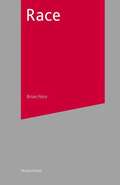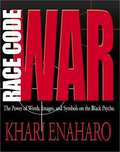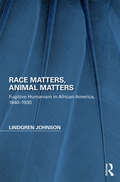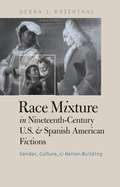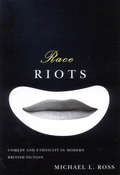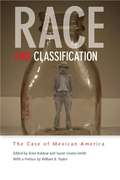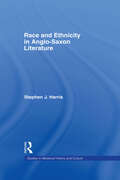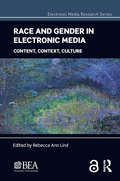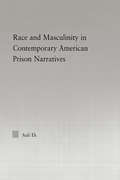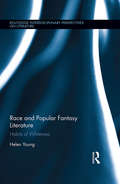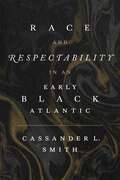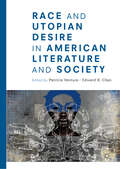- Table View
- List View
Race (Transitions Ser.)
by Brian NiroThis dynamic study of the history of the idea of race traces the concept from its prehistory across 400 years to its current status. Brian Niro introduces key theorists and philosophers and a wide variety of literary and theoretical concepts, taking the central view that the notion of race is a fluid concept that has altered consistently since its inception in Western ideology. Starting with Greek philosophy, Niro moves effortlessly through such diverse writers as Shakespeare, Voltaire, Kant, Mary Shelly, Darwin, Fanon and Achebe in order to explore the representation of race in its various guises. Many contemporary discussions of race are intricate and limited in their scope to current doctrine, but by using a series of close readings of often-studied texts, Niro helps to demonstrate key ideas and make complex theories understandable.
Race Characters: Ethnic Literature and the Figure of the American Dream
by Swati RanaA vexed figure inhabits U.S. literature and culture: the visibly racialized immigrant who disavows minority identity and embraces the American dream. Such figures are potent and controversial, for they promise to expiate racial violence and perpetuate an exceptionalist ideal of America. Swati Rana grapples with these figures, building on studies of literary character and racial form. Rana offers a new way to view characterization through racialization that creates a fuller social reading of race. Situated in a nascent period of ethnic identification from 1900 to 1960, this book focuses on immigrant writers who do not fit neatly into a resistance-based model of ethnic literature. Writings by Paule Marshall, Ameen Rihani, Dalip Singh Saund, Jose Garcia Villa, and Jose Antonio Villarreal symbolize different aspects of the American dream, from individualism to imperialism, assimilation to upward mobility. The dynamics of characterization are also those of contestation, Rana argues. Analyzing the interrelation of persona and personhood, Race Characters presents an original method of comparison, revealing how the protagonist of the American dream is socially constrained and structurally driven.
Race Characters: Ethnic Literature and the Figure of the American Dream
by Swati RanaA vexed figure inhabits U.S. literature and culture: the visibly racialized immigrant who disavows minority identity and embraces the American dream. Such figures are potent and controversial, for they promise to expiate racial violence and perpetuate an exceptionalist ideal of America. Swati Rana grapples with these figures, building on studies of literary character and racial form. Rana offers a new way to view characterization through racialization that creates a fuller social reading of race. Situated in a nascent period of ethnic identification from 1900 to 1960, this book focuses on immigrant writers who do not fit neatly into a resistance-based model of ethnic literature. Writings by Paule Marshall, Ameen Rihani, Dalip Singh Saund, Jose Garcia Villa, and Jose Antonio Villarreal symbolize different aspects of the American dream, from individualism to imperialism, assimilation to upward mobility. The dynamics of characterization are also those of contestation, Rana argues. Analyzing the interrelation of persona and personhood, Race Characters presents an original method of comparison, revealing how the protagonist of the American dream is socially constrained and structurally driven.
Race Code War
by Khari EnaharoThis book is designed to increase awareness of Black and White people as to the role of communication in the continuing practice of racism and racial alienation. It is also designed to expose the use of racially loaded and color-coded language.
Race Matters, Animal Matters: Fugitive Humanism in African America, 1840-1930 (Perspectives on the Non-Human in Literature and Culture)
by Lindgren JohnsonRace Matters, Animal Matters challenges one of the grand narratives of African American studies: that African Americans rejected racist associations of blackness and animality through a disassociation from animality. Analyzing canonical texts written by Frederick Douglass, Charles Chesnutt, Ida B. Wells, and James Weldon Johnson alongside slaughterhouse lithographs, hunting photography, and sheep “husbandry” manuals, Lindgren Johnson argues instead for a critical African American tradition that at pivotal moments reconsiders and recuperates discourses of animality weaponized against both African Americans and animals. Johnson articulates a theory of “fugitive humanism” in which these texts fl ee both white and human exceptionalism, even as they move within and seek out a (revised) humanist space. The focus, for example, is not on how African Americans shake off animal associations in demanding recognition of their humanity, but on how they hold fast to animality and animals in making such a move, revising “the human” itself as they go and undermining the binaries that helped to produce racial and animal injustices. Fugitive humanism reveals how an interspecies ethics develops in these African American responses to violent dehumanization. Illuminating those moments in which the African American canon exceeds human exceptionalism, Race Matters, Animal Matters ultimately shows how these black engagements with animals and animality are not subsequent to efforts for racial justice — a mere extension of the abolitionist or antilynching movements— but, to the contrary, are integral to those efforts. This black- authored temporality challenges widely accepted humanist approaches to the relationship between racial and animal justice as it anticipates and even critiques the valuable insights that animal studies and posthumanism have to offer in our current moment.
Race Mixture in Nineteenth-Century U.S. and Spanish American Fictions
by Debra J. RosenthalRace mixture has played a formative role in the history of the Americas, from the western expansion of the United States to the political consolidation of emerging nations in Latin America. Debra J. Rosenthal examines nineteenth-century authors in the United States and Spanish America who struggled to give voice to these contemporary dilemmas about interracial sexual and cultural mixing.Rosenthal argues that many literary representations of intimacy or sex took on political dimensions, whether advocating assimilation or miscegenation or defending the status quo. She also examines the degree to which novelists reacted to beliefs about skin differences, blood taboos, incest, desire, or inheritance laws. Rosenthal discusses U.S. authors such as James Fenimore Cooper, Catharine Maria Sedgwick, Walt Whitman, William Dean Howells, and Lydia Maria Child as well as contemporary novelists from Cuba, Peru, and Ecuador, such as Gertrudis Gomez de Avellaneda, Clorinda Matto de Turner, and Juan Leon Mera. With her multinational approach, Rosenthal explores the significance of racial hybridity to national and literary identity and participates in the wider scholarly effort to broaden critical discussions about America to include the Americas.
Race News: Black Journalists and the Fight for Racial Justice in the Twentieth Century
by Fred CarrollOnce distinct, the commercial and alternative black press began to crossover with one another in the 1920s. The porous press culture that emerged shifted the political and economic motivations shaping African American journalism. It also sparked disputes over radical politics that altered news coverage of some of the most momentous events in African American history. Starting in the 1920s, Fred Carroll traces how mainstream journalists incorporated coverage of the alternative press's supposedly marginal politics of anti-colonialism, anti-capitalism, and black separatism into their publications. He follows the narrative into the 1950s, when an alternative press re-emerged as commercial publishers curbed progressive journalism in the face of Cold War repression. Yet, as Carroll shows, journalists achieved significant editorial independence, and continued to do so as national newspapers modernized into the 1960s. Alternative writers' politics seeped into commercial papers via journalists who wrote for both presses and through professional friendships that ignored political boundaries. Compelling and incisive, Race News reports the dramatic history of how black press culture evolved in the twentieth century.
Race Riots
by Michael L. RossRoss examines racial humour as a manifestation of post-colonialism and questions contemporary critiques of "political correctness." Looking at cartoons from pre-World War II issues of Punch, Ross shows how disdain for non-Europeans plays a key role in period British humour and links this idea to the racial humour in the work of Evelyn Waugh and Joyce Cary. He also demonstrates how these assumptions are later turned on their heads by writers such as Salman Rushdie.
Race Riots: Comedy and Ethnicity in Modern British Fiction
by Michael L. RossRoss examines racial humour as a manifestation of post-colonialism and questions contemporary critiques of "political correctness." Looking at cartoons from pre-World War II issues of Punch, Ross shows how disdain for non-Europeans plays a key role in period British humour and links this idea to the racial humour in the work of Evelyn Waugh and Joyce Cary. He also demonstrates how these assumptions are later turned on their heads by writers such as Salman Rushdie.
Race and Classification: The Case of Mexican America
by Ilona Katzew Susan Deans-SmithAn exhibition of 18th-century casta painting at the Los Angeles County Museum of Art in 2004 occasioned a Mayday symposium from which the nine essays here emerged. Art and other historians, other scholars, and writers and artists explore the concepts and depictions of race in Mexico across the boundary from colonial to modern that is associated with the painting genre. Their topics include the language, genealogy, and classification of race in colonial Mexico; Moctezuma through the centuries; Hispanic identities in the southwestern US; and reconfiguring race, gender, and Chicano/a identity in film. Annotation c2010 Book News, Inc. , Portland, OR (booknews. com)
Race and Ethnicity in Anglo-Saxon Literature (Studies in Medieval History and Culture #24)
by Stephen HarrisWhat makes English literature English ? This question inspires Stephen Harris's wide-ranging study of Old English literature. From Bede in the eighth century to Geoffrey of Monmouth in the twelfth, Harris explores the intersections of race and literature before the rise of imagined communities. Harris examines possible configurations of communities, illustrating dominant literary metaphors of race from Old English to its nineteenth-century critical reception. Literary voices in the England of Bede understood the limits of community primarily as racial or tribal, in keeping with the perceived divine division of peoples after their languages, and the extension of Christianity to Bede's Germanic neighbours was effected in part through metaphors of family and race. Harris demonstrates how King Alfred adapted Bede in the ninth century; how both exerted an effect on Archbishop Wulfstan in the eleventh; and how Old English poetry speaks to images of race.
Race and Gender in Electronic Media: Content, Context, Culture (Electronic Media Research Series)
by Rebecca Ann LindThis volume examines the consequences, implications, and opportunities associated with issues of diversity in the electronic media. With a focus on race and gender, the chapters represent diverse approaches, including social scientific, humanistic, critical, and rhetorical. The contributors consider race and gender issues in both historical and contemporary electronic media, and their work is presented in three sections: content, context (audiences, effects, and reception), and culture (media industries, policy, and production). In this book, the authors investigate, problematize, and theorize a variety of concerns which at their core relate to issues of difference. How do we use media to construct and understand different social groups? How do the media represent and affect our engagement with and responses to different social groups? How can we understand these processes and the environment within which they occur? Although this book focuses on the differences associated with race and gender, the questions raised by and the theoretical perspectives presented in the chapters are applicable to other forms of socially-constructed difference. Chapters 5, 10, 12, and 19 of this book are freely available as downloadable Open Access PDFs at http://www.taylorfrancis.com under a Creative Commons Attribution-Non Commercial-No Derivatives (CC-BY-NC-ND) 4.0 license.
Race and History: Selected Essays 1938-1988
by John Hope FranklinThe essays are presented thematically and include pieces on southern history, significant but neglected historical figures, historiography, the connection between historical problems and contemporary issues, and the public role of the historian. His career has spanned a half century and in many ways parallels the emergence of Afro-American history as a legitimate area of inquiry.
Race and Identity in D. H. Lawrence
by Judith RudermanRace and Identity in D. H. Lawrence is a wide-ranging examination of Lawrence's adoption and adaptation of stereotypes about minorities, with a focus on three particular 'racial' groups. This book explores societal attitudes in England, Europe, and the United States and Lawrence's utilization of cultural norms to explore his own identity.
Race and Masculinity in Contemporary American Prison Novels
by Auli EkThis book offers an interdisciplinary analysis of how contemporary American prison narratives reflect and produce ideologies of masculinity in the United States, and in so doing, compellingly engages popular culture in order to demonstrate the profound ways in which implicit understandings of prison life shape all Americans, and their reactions to people both incarcerated and not.
Race and News: Critical Perspectives
by Christopher P. Campbell Rockell A. Brown Cheryl D. Jenkins Kim M. LeDuffThe history of American journalism is marked by disturbing representations of people and communities of color, from the disgraceful stereotypes of pre-civil rights America, to the more subtle myths that are reflected in routine coverage by journalists all over the country. Race and News: Critical Perspectives aims to examine these journalistic representations of race, and in doing so to question whether or not we are living in a post-racial world. By looking at national coverage of stories like the Don Imus controversy, Hurricane Katrina, Barak Obama's presidential candidacy, and even the Virginia Tech shootings, readers are given an opportunity to gain insight into both subtle and overt forms of racism in the newsroom and in national dialogue. The book itself is divided into two sections, with the first examining the journalistic routine and the decisions that go into covering a story with, or without, relation to race. The second section, comprised of case studies, explores the coverage of national stories and how they have impacted the dialogue on race and racism in the United States. As a whole, the collection of essays and studies also reflects a variety of research approaches. With a goal of contributing to the discussion about race and its place in American journalism, this broad examination makes Race and News an ideal text for courses on cultural diversity and the media, as well as making it valuable to professional journalists and journalism students who seek to improve their approach to coverage of diverse communities.
Race and Popular Fantasy Literature: Habits of Whiteness (Routledge Interdisciplinary Perspectives on Literature)
by Helen YoungThis book illuminates the racialized nature of twenty-first century Western popular culture by exploring how discourses of race circulate in the Fantasy genre. It examines not only major texts in the genre, but also the impact of franchises, industry, editorial and authorial practices, and fan engagements on race and representation. Approaching Fantasy as a significant element of popular culture, it visits the struggles over race, racism, and white privilege that are enacted within creative works across media and the communities which revolve around them. While scholars of Science Fiction have explored the genre’s racialized constructs of possible futures, this book is the first examination of Fantasy to take up the topic of race in depth. The book’s interdisciplinary approach, drawing on Literary, Cultural, Fan, and Whiteness Studies, offers a cultural history of the anxieties which haunt Western popular culture in a century eager to declare itself post-race. The beginnings of the Fantasy genre’s habits of whiteness in the twentieth century are examined, with an exploration of the continuing impact of older problematic works through franchising, adaptation, and imitation. Young also discusses the major twenty-first century sub-genres which both re-use and subvert Fantasy conventions. The final chapter explores debates and anti-racist praxis in authorial and fan communities. With its multi-pronged approach and innovative methodology, this book is an important and original contribution to studies of race, Fantasy, and twenty-first century popular culture.
Race and Respectability in an Early Black Atlantic
by Cassander L. SmithRace and Respectability in an Early Black Atlantic examines the means through which people of African descent embodied tenets of respectability as a coping strategy to navigate enslavement and racial oppression in the early Black Atlantic world. The term “respectability politics” refers to the way members of a minoritized population adopt the customs and manners of a dominant culture in order to gain visibility and combat negative stereotypes about their subject group. Today respectability politics can be seen in how those within and outside Black communities police the behavior of Black celebrities, critique protest movements, and celebrate accomplishments by people of African descent who break racial barriers.To study the origins of the complicated relationship between race and respectability, Cassander L. Smith shows that early American literatures reveal Black communities engaging with issues of respectability from the very beginning of the transatlantic slave trade. Concerns about character and comportment influenced the literary production of Black Atlantic communities, particularly in the long eighteenth century. Uncovering the central importance of respectability as a theme shaping the literary development of cultures throughout the early Black Atlantic, Smith illuminates the mechanics of respectability politics in a range of texts, including poetry, letters, and life writing by Phillis Wheatley, Olaudah Equiano, and expatriates on the west coast of Africa in Sierra Leone.Through these early Black texts, Race and Respectability in an Early Black Atlantic considers respectability politics as a malleable strategy that has both energized and suppressed Black cultures for centuries.
Race and Upward Mobility: Seeking, Gatekeeping, and Other Class Strategies in Postwar America
by Elda María RománOver the course of the twentieth and twenty-first centuries, Mexican American and African American cultural productions have seen a proliferation of upward mobility narratives: plotlines that describe desires for financial solvency, middle-class status, and social incorporation. Yet the terms "middle class" and "upward mobility"—often associated with assimilation, selling out, or political conservatism—can hold negative connotations in literary and cultural studies. Surveying literature, film, and television from the 1940s to the 2000s, Elda María Román brings forth these narratives, untangling how they present the intertwined effects of capitalism and white supremacy. Race and Upward Mobility examines how class and ethnicity serve as forms of currency in American literature, affording people of color material and symbolic wages as they traverse class divisions. Identifying four recurring character types—status seekers, conflicted artists, mediators, and gatekeepers—that appear across genres, Román traces how each models a distinct strategy for negotiating race and class. Her comparative analysis sheds light on the overlaps and misalignments, the shared narrative strategies, and the historical trajectories of Mexican American and African American texts, bringing both groups' works into sharper relief. Her study advances both a new approach to ethnic literary studies and a more nuanced understanding of the class-based complexities of racial identity.
Race and Utopian Desire in American Literature and Society
by Edward K. Chan Patricia VenturaBringing together a variety of scholarly voices, this book argues for the necessity of understanding the important role literature plays in crystallizing the ideologies of the oppressed, while exploring the necessarily racialized character of utopian thought in American culture and society. Utopia in everyday usage designates an idealized fantasy place, but within the interdisciplinary field of utopian studies, the term often describes the worldviews of non-dominant groups when they challenge the ruling order. In a time when white supremacy is reasserting itself in the US and around the world, there is a growing need to understand the vital relationship between race and utopia as a resource for resistance. Utopian literature opens up that relationship by envisioning and negotiating the prospect of a better future while acknowledging the brutal past. The collection fills a critical gap in both literary studies, which has largely ignored the issue of race and utopia, and utopian studies, which has said too little about race.
Race and the Literary Encounter: Black Literature from James Weldon Johnson to Percival Everett (Blacks in the Diaspora)
by Lesley LarkinWhat effect has the black literary imagination attempted to have on, in Toni Morrison's words, "a race of readers that understands itself to be 'universal' or race-free"? How has black literature challenged the notion that reading is a race-neutral act? Race and the Literary Encounter takes as its focus several modern and contemporary African American narratives that not only narrate scenes of reading but also attempt to intervene in them. The texts interrupt, manage, and manipulate, employing thematic, formal, and performative strategies in order to multiply meanings for multiple readers, teach new ways of reading, and enable the emergence of antiracist reading subjects. Analyzing works by James Weldon Johnson, Zora Neale Hurston, Ralph Ellison, Jamaica Kincaid, Percival Everett, Sapphire, and Toni Morrison, Lesley Larkin covers a century of African American literature in search of the concepts and strategies that black writers have developed in order to address and theorize a diverse audience, and outlines the special contributions modern and contemporary African American literature makes to the fields of reader ethics and antiracist literary pedagogy.
Race and the Obama Phenomenon: The Vision of a More Perfect Multiracial Union
by G. Reginald Daniel and Hettie V. WilliamsThe concept of a more perfect union remains a constant theme in the political rhetoric of Barack Obama. From his now historic race speech to his second victory speech delivered on November 7, 2012, that striving is evident. “Tonight, more than two hundred years after a former colony won the right to determine its own destiny, the task of perfecting our union moves forward,” stated the forty-fourth president of the United States upon securing a second term in office after a hard-fought political contest. Obama borrows this rhetoric from the founding documents of the United States set forth in the US Constitution and in Abraham Lincoln's “Gettysburg Address.” How naive or realistic is Obama's vision of a more perfect American union that brings together people across racial, class, and political lines? How can this vision of a more inclusive America be realized in a society that remains racist at its core? These essays seek answers to these complicated questions by examining the 2008 and 2012 elections as well as the events of President Obama's first term. Written by preeminent race scholars from multiple disciplines, the volume brings together competing perspectives on race, gender, and the historic significance of Obama's election and reelection. The president heralded in his November 2012, acceptance speech, “The idea that if you're willing to work hard, it doesn't matter who you are, or where you come from, or what you look like . . . . whether you're black or white, Hispanic or Asian or Native American.” These essayists argue the truth of that statement and assess whether America has made any progress toward that vision.
Race and the Production of Modern American Nationalism (Wellesley Studies in Critical Theory, Literary History and Culture #No. 18)
by Reynolds J. Scott-childressFirst published in 1999. Routledge is an imprint of Taylor & Francis, an informa company.
Race and the Rhetoric of Resistance
by Jeffrey B. FergusonContinuing in the vein of his ever questioning the conventions of race melodrama through the lens of which so much American racial and cultural history and storytelling has been filtered, Ferguson's final work conveys to the reader his sense of humor, warmth, and grace, while adding up to a serious, principled critique of much common scholarly and pedagogic practice..
Race and the Totalitarian Century
by Vaughn RasberryVaughn Rasberry turns to black culture and politics for an alternative history of the totalitarian century. He shows how black writers reimagined the standard anti-fascist, anti-communist narrative through the lens of racial injustice, with the U.S. as a tyrannical force in the Third World but also an agent of Asian and African independence.
